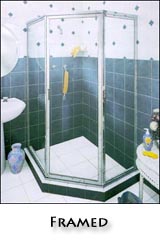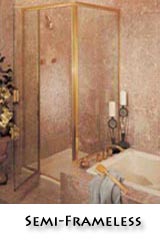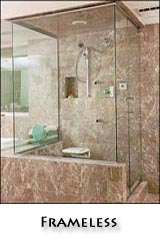
 |
||||||||
Shower & Tub Enclosures |
 |
 |
 |
What types of enclosures are there? There are three categories of shower or tub enclosures; "framed", "semi-frameless" and "frameless". Framed enclosures use metal framing around each piece of glass which makes up the enclosure; there are no exposed edges of glass. Semi-frameless enclosures provide an intermediate step with narrower bands of framing and no framing at all on the top and handle side of the door. Frameless enclosures are designed to minimize the use of framing without sacrificing the structural integrity of the unit; we use as little metal as is possible to provide a safe and structurally sound installation. What are some other considerations when selecting an enclosure? There are 2 general categories of metal framing; aluminum
and brass. Aluminum framing can be anodized or painted in a wide variety
of different colors and is the least expensive framing option. Brass framing
can be polished or plated (chrome, nickel, gold, etc) to take on a variety
of different finishes. Brass and plated brass provide for a more lustrous,
high-end appearance than aluminum and have a greater lead time and higher
cost. Real brass provides a beautiful appearance but does not come with
a finish warranty- brass will almost certainly require maintenance in
the form of polishing. Can I use any enclosure in any opening? Not always. As with most construction projects, planning ahead can save aggravation and problems down the road. If you elect to go with a fiberglass tub or shower surround you are typically limited to a framed or semi-frameless enclosure. These products are typically self-supporting and rely less on structural perimeter fastening than heavy-glass frameless enclosures; fiberglass or acrylic walls are typically not strong enough to support the weight of an 80 lb. frameless glass door. Tile, marble, granite and other wall surfaces typically lend themselves better to heavy glass frameless shower enclosures because the walls can be constructed to support the weight of a door. Tile and the Durock wallboard beneath the tile are not alone strong enough to support a door. Therefore, before the Durock is applied, it is extremely important that your builder installs wood reinforcing so that the glass hinges can be screwed through the tile and Durock into wood. This wood reinforcing should be installed in the walls, in-line with the shower threshold; we prefer a 2X6 on-the-flat (5 1/2" facing out)- a single 2x4 is not suitable (See diagram at bottom of this page). Stress plumb walls and level sills to your builder (even if he is installing a fiberglass surround). Although we can work around wall problems, they cost you more money and sometimes require additional framing which can detract from the enclosures appearance. Finally, make sure you and your contractor use common sense
What happens next? Contact us! Within our business area, we offer complete measuring and consulting services at no cost. Contact us by telephone if you have any basic design questions |
||